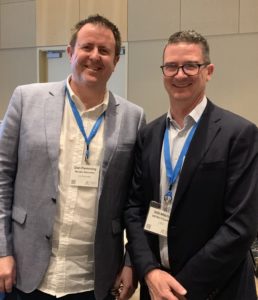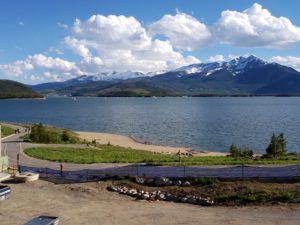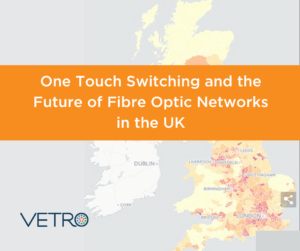Mountain Connect is known for fresh content. This year’s event in Keystone Colorado was no exception, focused on municipal broadband, community development, wireless and fixed wireless, and emerging technologies. The most common theme was how to leverage existing infrastructure, increase efficiency, and lower cost to provide high-speed broadband to rural areas.

VETRO FiberMap CEO Will Mitchell (right) and Render Co-Founder Dan Fleming (left).
Municipalities from a population base of a few thousand to over 100,000 attended this event. Their primary interests are connecting municipal buildings and traffic signals to fiber, exploring Fiber to the Home (FTTH) feasibility, and overbuilding their networks to lease out excess fiber capacity in the future. The ISP attendees were interested in fiber to the tower, and increasing their footprint and customer base through both fiber and the use of innovative wireless equipment.
There’s been a large, collaborative broadband effort at the county government level in Colorado, spurred by low population densities and relatively spread out town geography. Local control is emphasized as a necessity, in particular, from the conception of a county broadband project all the way through construction, operation and leasing. However, municipalities cite a lack of skilled, local labor as a barrier to fiber deployment, as well as the availability of soft money such as State and Federal grants.
Municipal Broadband in Colorado
Although it tends to be overlooked, marketing is one of the most critical components of a successful municipal (or private) broadband project. Population density—or cost per home passed—is not the only driver of the feasibility of a project; some areas with low density have high takes rates, and occasionally the opposite can be true. It’s essential to plan builds using data-driven intelligence to predict take rates and minimize risk, which is easily accessible using an Analysis with Polygons toolset.

Next-Generation Map Data
CostQuest Associates, one of VETRO FiberMap’s longtime partners, gave a compelling presentation on their work building a Broadband Serviceable Location Fabric. This project will result in a nationwide map data set of every location that’s either an expected network endpoint or a broadband consuming point. The data set covers residential, business, and occupied structures, but not towers, poles or small cell sites. The map will have rooftop-level accuracy, with addressed locations classified by type and unit counts. Eventually, this data could be a foundation for broadband availability reporting. In the meantime, it will serve as a convenient, uniform, accurate map base for fiber designs and reporting.
Key Takeaways:
- Rural broadband projects are still the key focus, with increasing numbers of municipal fiber projects cropping up in Colorado and beyond.
- Equipment and materials innovation is lowering the cost of broadband fiber deployment.
- Blockchain use cases are developing as a solution to managing transactions within the telecommunications sector. Early blockchain activities revolve around wireless inter-carrier billing settlement, but can extend to dark and lit fiber assets. This is an area of focus for VETRO FiberMap.
- Discussions continue around “disruptors,” such as the open-access model that enables ISPs to compete for last-mile customers.
- An average of 9.1 devices are connected to the internet per household (and growing). The demand for fiber has already arrived, and ISPs that monitor the growing bandwidth demand and adjust accordingly will be the ones that retain customers.
The VETRO FiberMap team enjoyed meeting with customers and partners old and new, including: Mammoth Networks, Gigabit Now, Foresite Group, CostQuest Associates, Duraline, Biarri, Render, Next Century Cities, ILSR, and more!
The smaller regional conferences allow for more direct engagement and “quality time” in networking. We look forward to participating in the next of this series, Great Lakes Connect, in Wisconsin this fall.


